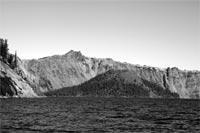Seismic monitoring stations wanted at Crater Lake
Herald and News
Klamath Falls, Oregon
September 17, 2005
By LEE JUILLERAT
No, Crater Lake isn’t expected to have renewed volcanic activity any time soon.
|
But, yes, geologists with the U.S. Geologic Survey and Crater Lake National Park officials would like to install six to 10 seismic monitoring stations at and near the park.
“The threat isn’t that great,” said Willie Scott, a geologist with the U.S. Cascades Volcano Observatory in Vancouver, Wash., of a possible eruption. “Still, the level of monitoring is minimal and needs to be improved.”
A recent USGS report on a proposed National Volcano Early Warning System said Crater Lake receives the least monitoring for possible eruptions among the region’s five most active volcanoes, partly because it lies so far from population centers.
”Crater Lake is the worst-case scenario,” said observatory seismologist Seth Moran. ”Mount Saint Helens taught us that we need a decent network of seismic monitors or else we might miss the subtle signs (of volcanism). Once they wake up, they’re too hot to get close to.”
There is a network of seismic monitors up and down the Cascades, but the monitor nearest to Crater Lake is 29 miles away.
”In every (other) case, volcanoes have a monitor within five miles, but Crater Lake is a remote volcano, not near any town, and it hasn’t erupted very recently,” Moran said. ”To be frank, resources are limited, so we have to concentrate on the most likely ones: Rainier, Hood and South Sister.”
Geologists say the five Oregon volcanoes most likely to become active are Hood, Jefferson, South Sister, Newberry and Crater Lake. In far northern California, volcanoes of concern include Shasta, Lassen and Medicine Lake.
“We’re proposing a long-term strategy to improve volcanic monitoring in the U.S.,” Scott said. “A lot of volcanic swarms and earthquakes are very small, and being able to locate them precisely is very important.”
Scott said implementing the desired network would cost about $15 million annually, which includes installation, extra personnel and maintenance.
Crater Lake’s cataclysmic eruption happened about 7,700 years ago. Wizard Island, the volcanic cone within the caldera, erupted about 5,000 years ago. The eruption of the former Mount Mazama was among the most spectacular volcanic events and left a huge caldera that filled with rain and snow melt.
Since then, the only recorded signs of volcanic activity have included gaseous clouds that emerged through the summer of 1945 and earthquakes that measured up to 6.0 magnitude in 1993.
“We have no indications that Crater Lake is poised to erupt,” said Mac Brock, the park’s chief of natural resources, who said the report has caused some people to wonder if an eruption is imminent.
The park had a monitor several years ago but Brock said it was removed. He said park officials have discussed the desire for seismic monitoring systems “because it’s always been something we’d like to do,” but no proposals have been made.
Scott said the proposed monitoring station would include a station the size of a big steel toolbox on the ground or partially buried, a thermometer-sized sensor, a mast and antenna, and solar-powered battery panel.
“Restless volcanoes do not always progress to eruption,” the USGS reports says. “Nevertheless, monitoring is necessary in such cases to minimize either over-reacting, which costs money, or under-reacting, which may cost lives.”
The Associated Press contributed to this story.
On the Web: volcanoes.usgs.gov
Other pages in this section


